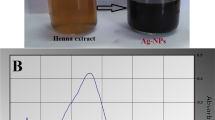Abstract
Pseudomonas aeruginosa is a well-known clinical pathogen for its recalcitrant infection caused by biofilm formation which are initiated by flagella-mediated attachment. Sodium houttuyfonate (SH) is a natural phytoanticipin derivative of houttuynin and has anti-pathogenic effect on P. aeruginosa biofilm formation. In this paper, when using 1/2 × MIC SH, the diameter of P. aeruginosa swimming motility was sharply shortened to 36 % in 24 h incubation, and the fold changes of fliC required for swimming motility was 0.36 in 24 h cultivation, the adherence inhibition accounted for about 46 %, and the pyocyanin production decreased to 47 % after 1-day treatment and 56 % after 3-day treatment with obvious visual changes from dark green to light green, compared with the negative control. With the help of mass spectra and scanning electronic microscope, 1/2 × MIC SH was further testified to be enough to eradicate flagella and inhibit pyocyanin secretion of P. aeruginosa. The results do not only re-affirm the close interplay of attachment and virulence (i.e. swimming motility and pyocyanin), but also unravel the potential mechanism of SH on anti-biofilm of P. aeruginosa.





Similar content being viewed by others
Abbreviations
- SH:
-
Sodium houttuyfonate
- MS:
-
Mass spectrum
- SEM:
-
Scanning electronic microscope
- AZM:
-
Azithromycin
- MIC:
-
Minimal inhitory concentration
- PBS:
-
Phosphate buffer saline
- SD:
-
Standard deviation
References
Gao JP, Chen CX, Wang Y, Lu J, Gu WL (2009) Effect of sodium houttuyfonate on myocardial hypertrophy in mice and rats. J Pharm Pharmacol 61(5):677–683. doi:10.1211/jpp/61.05.0018
Henrichsen J (1972) Bacterial surface translocation: a survey and a classification. Bacteriol Rev 36(4):478–503
Kosuge T (1952) Structure of an antimicrobial substance isolated from Houttuynia cordata Thunb. J Pharm Sac Japan 72(3):12271–12275
Lau GW, Hassett DJ, Ran H, Kong F (2004a) The role of pyocyanin in Pseudomonas aeruginosa infection. Trends Mol Med 10(12):599–606. doi:10.1016/j.molmed.2004.10.002
Lau GW, Ran H, Kong F, Hassett DJ, Mavrodi D (2004b) Pseudomonas aeruginosa pyocyanin is critical for lung infection in mice. Infect Immun 72(7):4275–4278. doi:10.1128/IAI.72.7.4275-4278.2004
Lindhout T, Lau PC, Brewer D, Lam JS (2009) Truncation in the core oligosaccharide of lipopolysaccharide affects flagella-mediated motility in Pseudomonas aeruginosa PAO1 via modulation of cell surface attachment. Microbiology 155(10):3449–3460. doi:10.1099/mic.0.030510-0
Liu G, Xiang H, Tang X, Zhang K, Wu X, Wang X, Guo N, Feng H, Wang G, Liu L, Shi Q, Shen F, Xing M, Yuan P, Liu M, Yu L (2011) Transcriptional and functional analysis shows sodium houttuyfonate-mediated inhibition of autolysis in Staphylococcus aureus. Molecules 16(10):8848–8865. doi:10.3390/molecules16108848
Livak KJ, Schmittgen TD (2001) Analysis of relative gene expression data using real-time quantitative PCR and the 2−ΔΔCT method. Methods 25(4):402–408. doi:10.1006/meth.2001.1262
Mann EE, Wozniak DJ (2012) Pseudomonas biofilm matrix composition and niche biology. FEMS Microbiol Rev 36(4):893–916. doi:10.1111/j.1574-6976.2011.00322.x
Morales DK, Grahl N, Okegbe C, Dietrich LE, Jacobs NJ, Hogan DA (2013) Control of Candida albicans Metabolism and Biofilm Formation by Pseudomonas aeruginosa Phenazines. mBio 4(1). doi:10.1128/mBio.00526-12
Murray TS, Kazmierczak BI (2006) FlhF is required for swimming and swarming in Pseudomonas aeruginosa. J Bacteriol 188(19):6995–7004. doi:10.1128/JB.00790-06
Murray TS, Kazmierczak BI (2008) Pseudomonas aeruginosa exhibits sliding motility in the absence of type IV pili and flagella. J Bacteriol 190(8):2700–2708. doi:10.1128/JB.01620-07
Norman RS, Moeller P, McDonald TJ, Morris PJ (2004) Effect of pyocyanin on a crude-oil-degrading microbial community. Appl Environ Microbiol 70(7):4004–4011. doi:10.1128/AEM.70.7.4004-4011.2004
O’Toole GA, Kolter R (1998) Flagellar and twitching motility are necessary for Pseudomonas aeruginosa biofilm development. Mol Microbiol 30(2):295–304. doi:10.1046/j.1365-2958.1998.01062.x
Pompilio A, Crocetta V, Confalone P, Nicoletti M, Petrucca A, Guarnieri S, Fiscarelli E, Savini V, Piccolomini R, Di Bonaventura G (2010) Adhesion to and biofilm formation on IB3-1 bronchial cells by Stenotrophomonas maltophilia isolates from cystic fibrosis patients. BMC Microbiol 10(1):102
Rashid MH, Kornberg A (2000) Inorganic polyphosphate is needed for swimming, swarming, and twitching motilities of Pseudomonas aeruginosa. Proc Natl Acad Sci USA 97(9):4885–4890. doi:10.1073/pnas.060030097
Reimer Å (2000) Concentrations of the Pseudomonas aeruginosa toxin pyocyanin in human ear secretions. Acta Otolaryngol (Stockh) 120(543):86–88. doi:10.1080/000164800454062
Sauer K, Camper AK, Ehrlich GD, Costerton JW, Davies DG (2002) Pseudomonas aeruginosa displays multiple phenotypes during development as a biofilm. J Bacteriol 184(4):1140–1154. doi:10.1128/jb.184.4.1140-1154.2002
Shao J, Cheng HJ, Wang CZ, Wang Y (2012) A phytoanticipin derivative, sodium houttuyfonate, induces in vitro synergistic effects with levofloxacin against biofilm formation by Pseudomonas aeruginosa. Molecules 17(9):11242–11254. doi:10.3390/molecules170911242
Wang HZ, Wu H, Ciofu O, Song Z, Hoiby N (2012) In vivo pharmacokinetics/pharmacodynamics of colistin and imipenem in Pseudomonas aeruginosa biofilm infection. Antimicrob Agents Chemother 56(5):2683–2690. doi:10.1128/AAC.06486-11
Ye X, Li X, Yuan L, Ge L, Zhang B, Zhou S (2007) Interaction of houttuyfonate homologues with the cell membrane of gram-positive and gram-negative bacteria. Colloids Surf A 301(1–3):412–418. doi:10.1016/j.colsurfa.2007.01.012
Zeng X, Liu X, Bian J, Pei G, Dai H, Polyak SW, Song F, Ma L, Wang Y, Zhang L (2011) Synergistic effect of 14-alpha-lipoyl andrographolide and various antibiotics on the formation of biofilms and production of exopolysaccharide and pyocyanin by Pseudomonas aeruginosa. Antimicrob Agents Chemother 55(6):3015–3017. doi:10.1128/AAC.00575-10
Acknowledgments
This work was supported by the National Natural Science Foundation of China (No. 81173629).
Conflict of interest
The authors declare no conflict of interest.
Author information
Authors and Affiliations
Corresponding author
Electronic supplementary material
Below is the link to the electronic supplementary material.
Rights and permissions
About this article
Cite this article
Shao, J., Cheng, H., Wang, C. et al. Sodium houttuyfonate, a potential phytoanticipin derivative of antibacterial agent, inhibits bacterial attachment and pyocyanine secretion of Pseudomonas aeruginosa by attenuating flagella-mediated swimming motility. World J Microbiol Biotechnol 29, 2373–2378 (2013). https://doi.org/10.1007/s11274-013-1405-2
Received:
Accepted:
Published:
Issue Date:
DOI: https://doi.org/10.1007/s11274-013-1405-2




